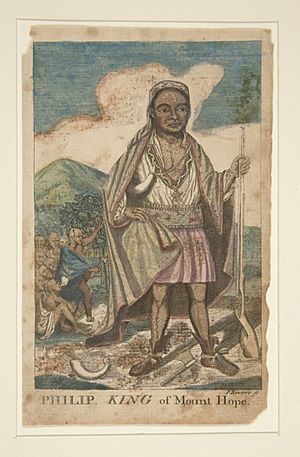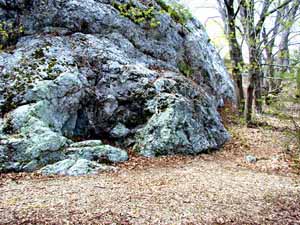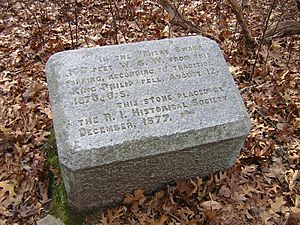Metacomet facts for kids
Quick facts for kids
Metacom
|
|
|---|---|
 |
|
| Wampanoag Sachem | |
| Preceded by | Wamsutta |
| Succeeded by | Annawan |
| Personal details | |
| Born | 1638 |
| Died | August 12, 1676 (aged 37–38) Bristol, Rhode Island |
| Cause of death | Assassinated |
Metacomet (born in 1638, died August 12, 1676) was a very important leader of the Wampanoag people. He was also known by his English name, King Philip. He became the chief, or sachem, of his people in 1662. His father, Massasoit, was also a famous sachem. Metacomet's brother, Wamsutta, was chief before him but died young.
Metacomet first tried to live peacefully with the English colonists. He traded with them and even bought his clothes in Boston, Massachusetts. But as the colonies grew, they took more and more land. This caused a lot of tension. In 1675, a big conflict called King Philip's War began. Metacomet led many Native American tribes against the English to try and stop their expansion. He was killed in 1676 during this war.
Becoming King Philip
In 1660, Metacomet's brother, Wamsutta, asked the court in Plymouth Colony for English names for himself and Metacomet. This was a Wampanoag custom to mark important life changes. The court agreed. Wamsutta's name became Alexander, and Metacomet's became Philip. The English later started calling him "King Philip."
King Philip's War
King Philip wanted to stop the English colonists from taking more land. He worked with many other Native American tribes in New England. They all shared similar problems. The colonists were expanding, and there was less land for hunting.
The war started in 1675. King Philip and his followers fought bravely. They tried to push the European colonists out of New England. As the fighting continued, King Philip and some of his people hid in a large swamp in southern Massachusetts.
On August 12, 1676, King Philip was found by a group of rangers. He was shot and killed near Mount Hope in Bristol, Rhode Island. After his death, his wife and young son were captured. They were then sold into slavery far away in the West Indies.
Legacy

Many places are named after Metacomet or King Philip:
- The Metacomet Mill in Fall River, Massachusetts, built in 1847, is the oldest textile mill there.
- King Philip Stockade is a large park in Forest Park in Springfield, Massachusetts.
- The USS Metacomet was a United States Navy ship from 1863.
- The Metacomet Ridge is a 100-mile long mountain range in southern New England.
- The 51-mile Metacomet Trail is in central Connecticut.
- The 110-mile Metacomet-Monadnock Trail is in Massachusetts and southern New Hampshire.
- Metacomet Country Club is a golf course in East Providence, Rhode Island.
- Metacomet Park is in Medfield, Massachusetts.
- Metacom Avenue is a major road in Bristol, Rhode Island and Warren, Rhode Island.
- King Philip Regional High School serves Plainville, Wrentham, and Norfolk, Massachusetts.
- King Philip Middle School is in West Hartford, Connecticut.
- King Phillip's Cave in Norton, Massachusetts is said to have been a hiding place for him.
- King Philip Mountain is a peak near Hartford, Connecticut.
See also
 In Spanish: Metacomet para niños
In Spanish: Metacomet para niños


